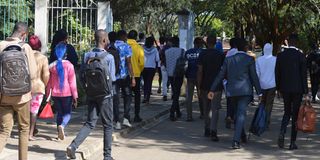Encourage youth to vote in national elections

Egerton University Njoro Campus students on September 23, 2021. The Independent Electoral and Boundaries Commission (IEBC) has set up biometric equipment at the institution to enable students register as voters.
Young people aged 15 to 25 constitute a fifth of the world’s population. While they are often involved in informal politically relevant processes, such as activism or civic engagement, they are not formally represented in national political institutions such as parliaments and many of them don’t participate in elections.
Young people vote less frequently, vie as candidates less often and are usually under-represented in electoral managerial functions. Notwithstanding that in some cases youth are the most mobile segment of a society. Sometimes because of that, many youth, especially from marginalised groups, face access barriers to electoral processes.
Youth who are transitioning into adulthood are often moving between households and employment or study locations. In many contexts, young people with disabilities face unique obstacles to casting their votes.
Cultural norms
These include cultural norms that prescribe that women should not be involved in politics or that politics is the domain of men, concerns about the safety of journeys to voting centres and security there, and illiteracy levels, which are still disproportionally high among women.
To counter youth-specific obstacles to voting, electoral bodies should explore different options to engage youth voters and make voting more convenient during elections. One of these could be organising outreach campaigns for first-time voters to celebrate voting as a rite of passage.
This could include giving youth a letter and education material from the government with information on how to register and vote.
An education programme for young voters within schools and elsewhere can cover the role and purpose of elections in democracies, the election process itself, how to vote and the rights and responsibilities of voters.
Social media
Social media and other apps can help to reach young voters, who use these as a primary source of communication and information. An example is creating apps that keep members updated with elections and voting requirements across the country. It can also send reminders when voters need to register and vote and can assist with absentee voters.
Educating young people about voting takes time and resources. Setting up a subcommittee of staff members or volunteers to focus on youth education is one way of prioritising youth engagement while allowing other election officials to focus on other important tasks.
The group will focus on registering students, familiarising them with voting machines and encouraging them to get out and vote. To increase voter participation among youth, the government can also partner with respective universities to provide information about voter registration and answer questions or concerns from students.
Kelsie Dorita, Kisumu




